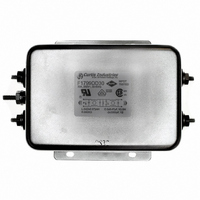F1799DD30 Curtis Industries, F1799DD30 Datasheet - Page 87

F1799DD30
Manufacturer Part Number
F1799DD30
Description
FILTER HI PERFORM 30A SCREW
Manufacturer
Curtis Industries
Series
F1799r
Datasheet
1.F3000AA06.pdf
(92 pages)
Specifications of F1799DD30
Filter Type
Power Line
Voltage - Rated
250V
Current
30A
Mounting Type
Chassis Mount
Termination Style
Stud Lug
Lead Free Status / RoHS Status
Lead free / RoHS Compliant
Inductance
-
Other names
364-1142
What is RFI?
Radio frequency interference (RFI) is the radiation or
conduction of radio frequency energy (or electronic
noise) produced by electrical and electronic devices
at levels that interfere with the operation of adjacent
equipment. Frequency ranges of most concern are
10 kHz to 30 MHz (conducted) and 30 MHz to 1 GHz
(radiated).
What causes RFI?
The most common sources include components
such as switching power supplies, relays, motors and
triacs. These devices are found in a wide variety of
equipment used in industrial, medical, white goods,
and building HVAC equipment.
What are the types of RFI?
An electrical or electronic device emits RFI in two
●
●
How can RFI be controlled?
●
●
The filter suppresses conducted noise leaving the
unit, reducing RFI to acceptable levels. It also helps to
lower the susceptibility of the equipment to incoming
power line noise that can affect its performance.
What is the government’s role in
regulating RFI?
Governments and safety agencies of major industrial
countries, including the United States, Canada, and
the European Union have established noise emission
regulations that are focused on digital and other
electronic equipment. The most important of these
guidelines are FCC CFR 47 (Parts 15 and 18) in
the United States and CISPR 11, 14 and 22 in the
European Union.
Dimensions are in inches and millimeters
unless otherwise specified.
Values in parentheses are metric equivalents.
ways:
Radiated RFI is emitted directly into the environment
from the equipment itself.
Conducted RFI is released from components and
equipment through the power line cord into the AC
power line network. This conducted RFI can affect
the performance of other devices on the same
network.
Radiated RFI is usually controlled by providing
proper shielding in the enclosure of the equipment.
Conducted RFI can be attenuated to satisfactory
levels by including a power line filter in the system.
FCC CFR 47 (Part 15) regulates the RF
Curtis Industries
A Division of Powers Holdings, Inc.
interference of electronic computing devices, defined
as any electronic device or system that generates
and uses timing signals or pulses at a rate in excess
of 10,000 pulses (cycles) per second and uses
digital techniques. This definition includes telephone
equipment that utilizes digital techniques and any
device or system that generates and uses radio
frequency energy for the purpose of performing data-
processing functions such as electronic computations,
operations, transformations, recording, filing, sorting,
storage, retrieval or transfer.
computing devices marketed for use in commercial,
industrial or business environments, and Class B
devices intended for use in a residential environment.
various national regulations and has established the
international standards CISPR 11, 14 and 22. CISPR
11 covers industrial, scientific and medical equipment.
CISPR 14 covers electrical and thermal appliances
and tools. CISPR 22 covers information technology
equipment.
agencies worldwide have established guidelines for all
electrical/electronic components. These include UL,
CSA and TUV. They are designed to protect against
shock and fire hazard.
How do RFI power line filters work?
Consisting of a multiple-port network of passive
components arranged as a dual low-pass filter, the RFI
filter attenuates radio frequency energy to acceptable
levels, while permitting the power frequency current
to pass through with little or no attenuation. Their
function, essentially, is to trap noise and to prevent it
from entering or leaving your equipment.
modes. Asymmetric or common mode noise
occurs between the line and ground. Symmetric or
differential mode is measured from line to line. See
the selection guide on page 2 under “Performance.”
FCC regulations are broken down into Class A
The European Union has harmonized the
In addition to governmental regulations, safety
RFI is conducted through a power line in two
1-800-657-0853
85



















